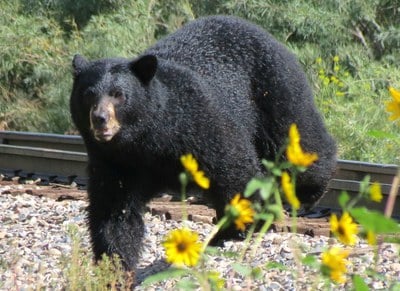WILDLIFE ON THE MOVE!

A black bear crosses the Durango Silverton Narrow Gauge Railroad tracks off US 550 north of Durango; photo may be used,
crediting Dan Bender, La Plata County Sheriff’s Office; see this, other photos and data on our Wildlife on the Move web page at: http://www.coloradodot.info/programs/environmental/wildlife/wildlifeonthemove
STATEWIDE – Get ready, Colorado drivers, wildlife are coming to town! Even this black bear is transitioning into hibernation, meaning she may be traversing more territory to look for just the right energy source. Deer are also moving down from the mountains. The Colorado Department of Transportation and Colorado State Patrol are reminding motorists that wildlife-vehicle collisions (WVCs) on highways are highest in the fall—particularly mid-September through November.
In Colorado there were 3,437 WVCs reported to law enforcement in 2013 (the most recent data), down from 4,016 in 2012 and below the 10-year average of 3,605. Of the 3,437 collisions, 3,183 involved vehicle damage, 250 involved injuries and 4 involved fatalities (source: CDOT Traffic & Safety Division).
“While enjoying the beautiful scenery along our state highways, please watch for wildlife on or near the road,” Colorado State Patrol Chief Scott Hernandez said. “Since more than 12 percent of the crashes investigated annually by the CSP involve animals, I encourage all drivers to avoid distractions and be aware of their surroundings at all times.”
Regardless of the number of cars on the road (high traffic counts or low), some counties top the list for high incidents of WVCs. In 2013, these counties topped the 100 mark: La Plata County at 252 wildlife-vehicle collisions; Jefferson County, 248; El Paso, 201; Douglas, 199; Garfield, 128; Moffat, 116; Larimer, 106; Montezuma, 106; (please see more county- and statewide data, here: http://www.coloradodot.info/programs/environmental/wildlife/wildlifeonthemove/data-and-charts. (Numbers above came from the chart entitled “Reported Wildlife-Vehicle Collisions by Type and County.”)
“What’s interesting is that we do see trends in wildlife-vehicle collisions statewide by year,” CDOT Biologist Jeff Peterson said. “When looking at the 10-year picture, there is a peak in most counties in 2004, again in 2012 and most counties saw a decrease this past year. While engineers can and do build mitigation features into highway projects—these statewide trends point to the need for drivers to mitigate as well.”
Wildlife-vehicle collisions happen year round, 24/7. However, there is always an increase during migration seasons—typically November for fall and June for the spring—and the majority occur during the hours between dusk and dawn. These collisions are not only a matter of safety, but can be quite costly as well.
"The average cost of deer-vehicle collisions is $3,400,” Carole Walker, executive director of the Rocky Mountain Insurance Information Association said. "So, drivers need to make sure they're insured by purchasing optional comprehensive coverage or end up paying out-of-pocket for damages.”
Nationwide, the insurance industry pays out nearly $1.1 billion a year in claims for all wildlife-vehicle collisions.
Slow down. Stay alert. Wildlife are on the move!
NOTE FOR ONLINE CHART INTERPRETATION: On CDOT’s Wildlife on the Move media page, there is a chart entitled “Reported Wildlife-Vehicle Collisions by Type & County;” the acronyms mean the following: PDO = property damage only; INJ = injury accident; FAT = fatal accident. Please note, the numbers indicate the number of accidents involving a PDO, injury/ies or fatality/ies. So a FAT of “3” or INJ of “3” for example does not indicate that 3 people died or were injured that year, but rather there were three wildlife-vehicle collisions where a human fatality or injury (or several fatalities or injuries) occurred.
For CDOT project information, sign up for free messages to your email or phone by going to www.coloradodot.info and choosing the green cell phone icon in the upper right corner, by calling 511, or by going to http://www.coloradodot.info/projects. Follow us on Twitter @coloradodot and on Facebook.
